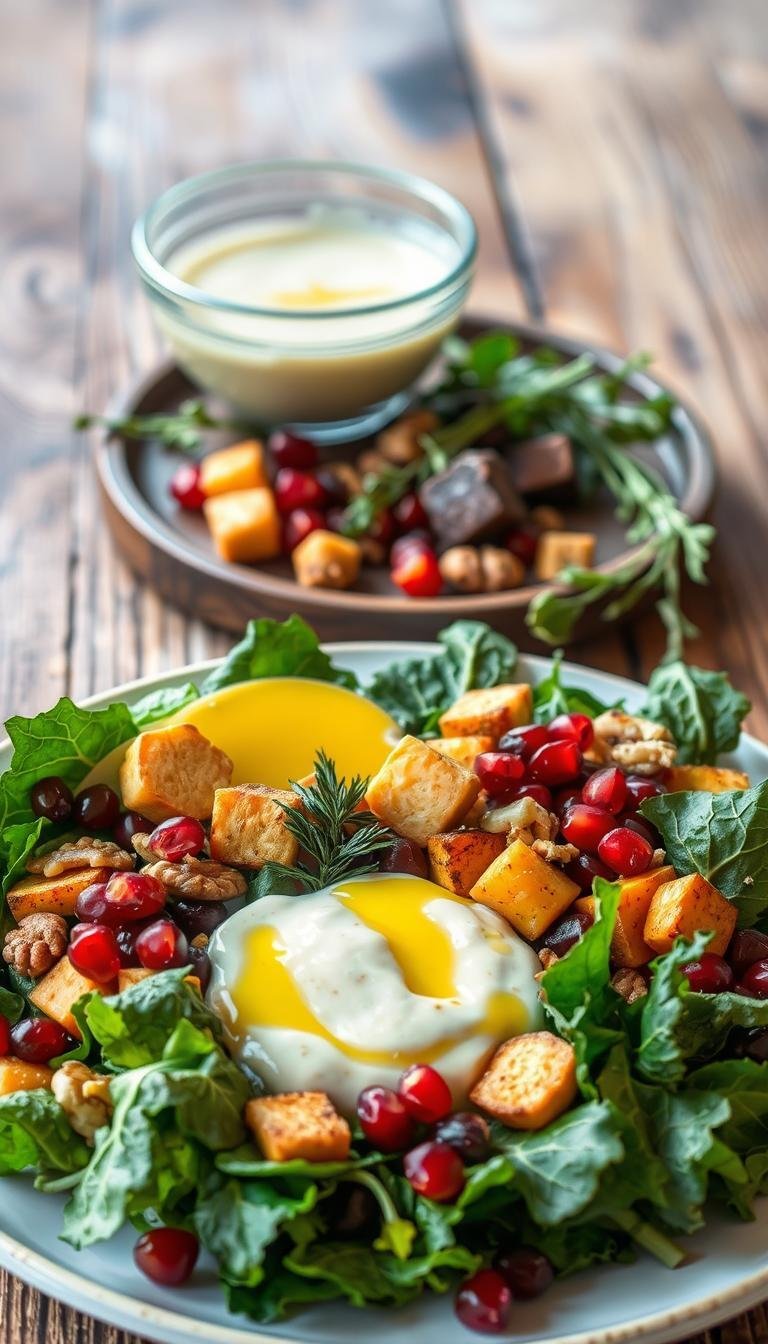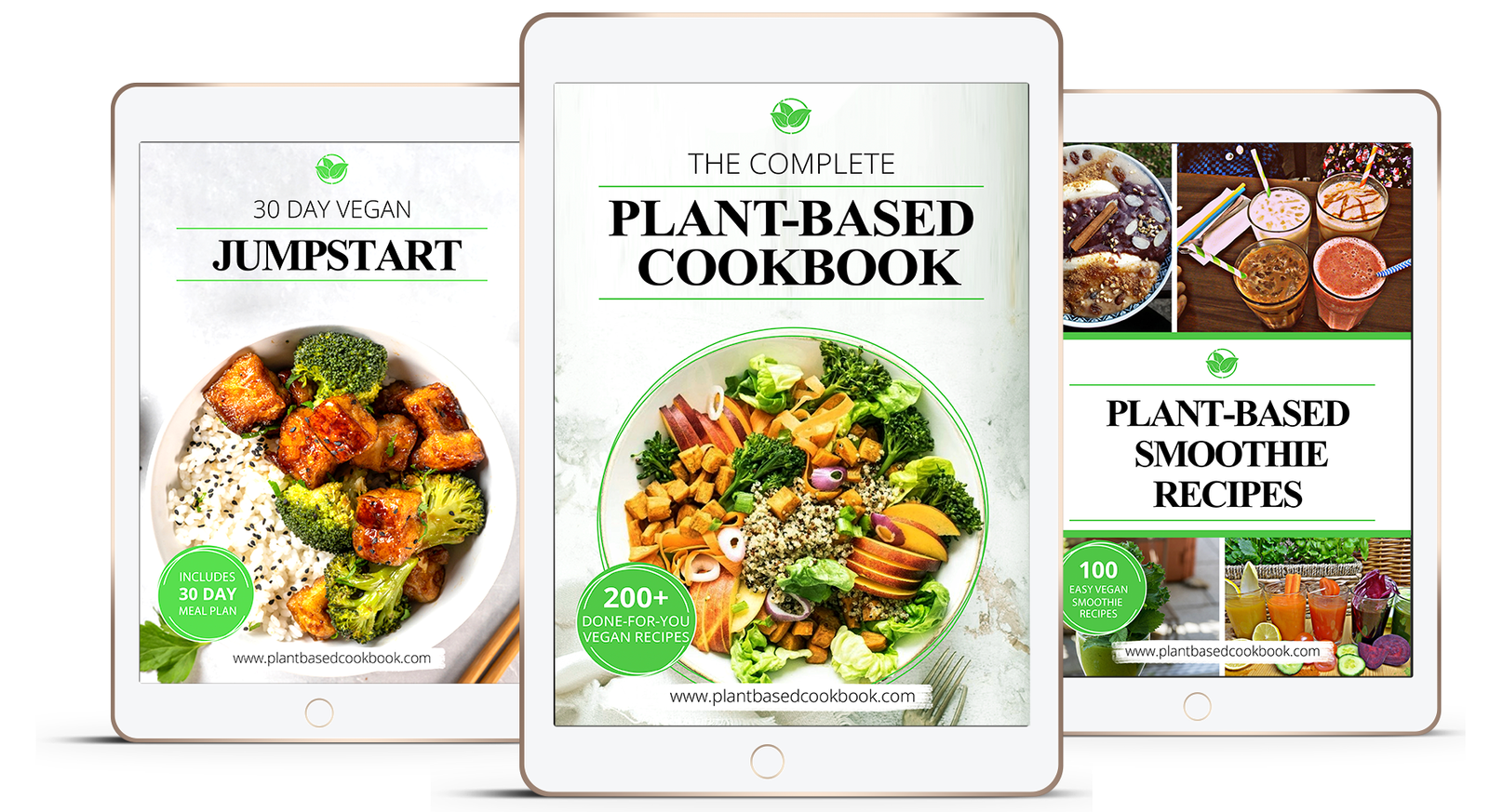(Hey! Some links in this post may be affiliate links — meaning I may earn a small commission if you buy through them, at no extra cost to you. As an Amazon Associate, I earn from qualifying purchases. I only share products I genuinely love and think you’ll find useful too. Read the full disclosure here).
Winter doesn’t mean you have to skip fresh salads. Winter salads are full of warmth and nutrition. They include roasted veggies and cozy flavors.
These salads are packed with vitamins to boost your energy during the cold months. Unlike summer salads, winter ones use ingredients like sweet potatoes and kale. They add depth and comfort to your meals.
This article will show you how to make satisfying, nutrient-rich salads. These salads will keep your meals exciting and nourishing all season long.
Contents
- 1 Why Winter Salads are Perfect for the Season
- 2 Key Ingredients for Delicious Winter Salads
- 3 Dressing Your Winter Salads
- 4 Creative Recipes for Winter Salads
- 5 Incorporating Grains into Salads
- 6 A Guide to Converting Leftovers into Salads
- 7 Pairing Winter Salads with Proteins
- 8 Tips for Meal Prepping Winter Salads
- 9 Serving Winter Salads for Gatherings
- 10 The Role of Nuts and Seeds in Salads
- 11 Common Mistakes to Avoid When Making Salads
Why Winter Salads are Perfect for the Season
Winter doesn’t mean salads have to stop. Seasonal salads and winter vegetable salads are not just easy to make. They’re also packed with nutrients.
These dishes use winter’s best produce. They taste great and are good for you too.
Nutritional Benefits of Winter Vegetables
Root veggies like carrots and beets are full of antioxidants and fiber. Leafy greens like kale and spinach have iron and vitamins.
Brussels sprouts and winter squash boost your immune system with vitamin C. Try a mix of roasted sweet potatoes, arugula, and a tangy dressing for a healthy bowl.
- Root vegetables = fiber and minerals
- Leafy greens = vitamins A and K
- Citrus fruits = immune-boosting vitamin C
Seasonal Ingredients to Elevate Flavor
Winter’s produce has bold flavors. Pomegranate seeds add a sweet crunch. Citrus fruits like oranges or grapefruits make bitter greens pop.
“The best winter salads balance earthy, roasted veggies with bright, acidic notes,” says registered dietitian Sarah Thompson.
Try roasted butternut squash with a maple-mustard dressing. Or toss endive leaves with blue cheese and walnuts. These combos make cold nights fun.
Choosing winter vegetable salads means you’re eating what’s best in season. You’re also giving your body the best nature has to offer.
Key Ingredients for Delicious Winter Salads
Creating tasty winter salads starts with the right ingredients. These pieces turn simple greens into hearty meals for cold weather. Let’s look at the essential ingredients for a satisfying bite.
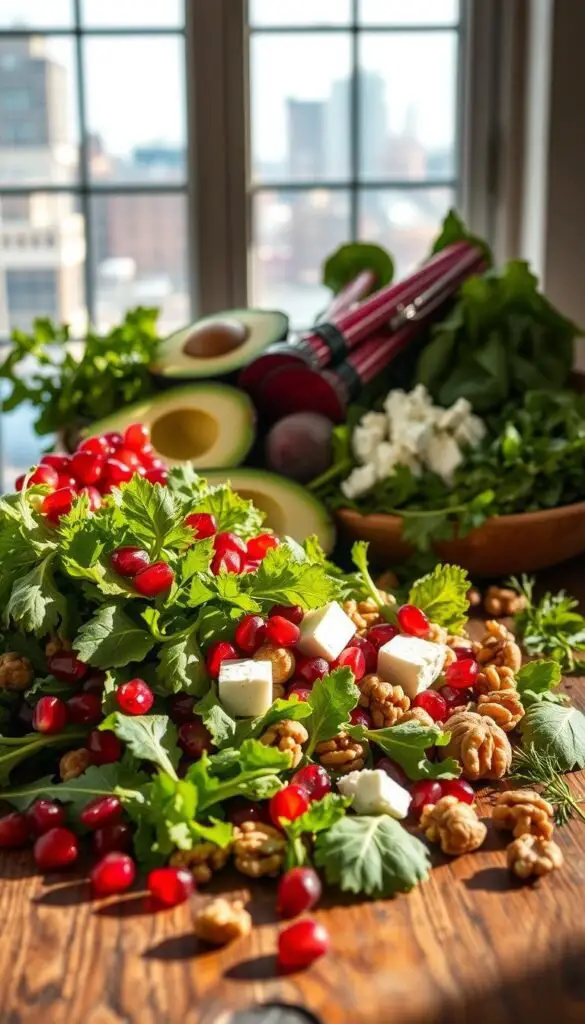
Leafy Greens to Choose From
Sturdy leafy greens are the base of any winter salad. Try:
- Kale: Massage with lemon juice to soften bitterness
- Spinach: Adds tenderness and iron-rich nutrition
- Arugula: Peppery leaves pair well with creamy dressings
- Endive: Crispy leaves for structure or as a wrap base
Crunchy Additions for Texture
Crunchy elements add texture and excitement. Incorporate:
- Toasted walnuts or almonds
- Apple slices for natural sweetness
- Jicama’s crisp texture
- Sunflower seeds for a nutty crunch
Toast nuts in a dry pan before adding for deeper flavor.
Protein Options for a Filling Meal
Protein turns salads into full meals. Options include:
- Grilled chicken strips
- Salmon for omega-3s
- Roasted chickpeas for vegetarians
- Quinoa as a plant-based protein source
“Adding protein transforms salads into hearty meal options,” says registered dietitian Sarah Thompson. “They keep you full longer, making salads more substantial.”
Mix greens, crunch, and protein for balanced dishes. These combinations help create hearty salad recipes for winter. Experiment with textures and flavors to find your perfect blend.
Dressing Your Winter Salads
Choosing the right dressing can make a simple salad a cozy winter favorite. Whether you make it from scratch or pick one from the store, the right dressing brings out the flavors of winter salads. It does this without overpowering them.
Homemade Dressings That Shine
Try these simple recipes to match your salad ingredients:
- Maple-Balsamic Vinaigrette: Mix balsamic vinegar, Dijon mustard, and pure maple syrup. This sweet tang goes great with roasted veggies.
- Creamy Tahini Dressing: Blend tahini, lemon juice, garlic, and warm water. This nutty dressing is perfect for leafy greens.
- Warm Bacon Vinaigrette: Simmer bacon fat with apple cider vinegar and honey. This smoky touch is great for grain-based cold weather salads.
Tip: Mix oils and acids slowly to avoid separation. Taste as you go—winter’s bold ingredients need balance.
💡 Want to build your own perfect winter salad?
Try our free Interactive Winter Salad Builder — a fun step-by-step tool that helps you mix and match greens, proteins, and cozy toppings to create your dream bowl in seconds.
Store-Bought Dressings: What to Look For
When you’re short on time, choose store-bought dressings carefully. Check the labels to avoid added sugars and artificial additives. Look for brands like Annie’s Naturals or Primal Kitchen, which focus on clean ingredients. Choose dressings with olive oil first and few preservatives.
Pairing ideas:
• Rich winter salads with hearty greens pair well with bold flavors like balsamic or mustard-based dressings.
• Lighter cold weather salads (like citrus-based) do well with oil-free options or milder herb dressings.
Whether you make it yourself or buy it, the right dressing is key. It brings your ingredients together and keeps meals lively all season.
Creative Recipes for Winter Salads
Make winter a time for vibrant, healthy meals with these easy recipes. They’re great for cozy nights or quick lunches. They mix seasonal tastes with simple steps.
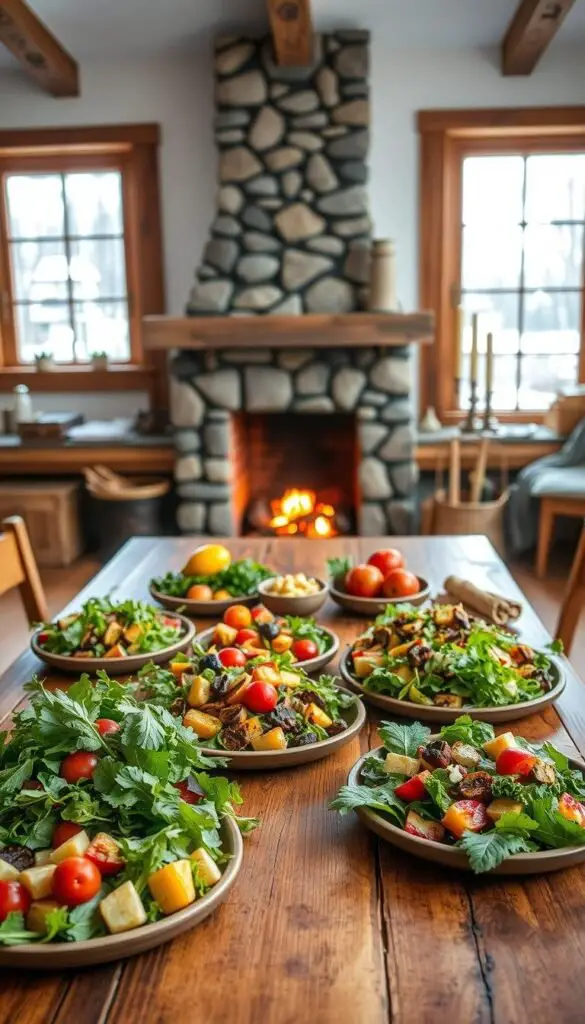
Warm Roasted Vegetable Salad
Roast root veggies until they’re sweet and caramelized. Then, mix them with arugula, feta, and a bit of balsamic glaze.
- Ingredients: Sweet potatoes, beets, Brussels sprouts, olive oil, salt, pepper, arugula, feta, balsamic vinegar.
- Instructions: Toss veggies with oil, roast at 400°F (200°C) for 30 mins. Combine with greens and toppings.
Pro tip:Let roasted veggies cool slightly before mixing to avoid wilting greens.
Citrus and Pomegranate Salad
Enjoy winter’s bright flavors with this colorful salad. Pomegranate seeds and citrus add juicy contrast to earthy greens.
- Ingredients: Mixed greens, blood oranges, pomegranate, avocado, mint, honey-lime dressing.
- Steps: Segment citrus by cutting and peeling; layer with greens and toppings. Drizzle and toss gently.
Quick trick:Use a sharp knife for clean citrus segments—no bitter pith!
Quinoa and Kale Power Salad
This salad is packed with protein for winter days. Cooked quinoa and massaged kale make a satisfying, nutrient-rich bowl.
- Ingredients: Quinoa, kale, cherry tomatoes, walnuts, dried cranberries, lemon-tahini dressing.
- Method: Cook quinoa, massage kale with lemon juice to soften, then combine all ingredients.
Meal prep note:Prep components ahead; assemble just before serving for best texture.
These recipes can be tailored to fit your diet. Swap proteins or adjust spice levels. These healthy winter recipes show salads can be exciting this season.
Incorporating Grains into Salads
Turn fresh winter salads into filling meals with grains. They add fiber, protein, and keep you full longer. Every bite becomes more enjoyable.
Nutritious Grain Options for Winter
Choose grains that match cold weather flavors. Try:
- Farro: Earthy and chewy, pairs well with citrus or roasted veggies.
- Barley: Creamy texture complements tangy dressings and dried fruits.
- Wild Rice: Nutty and fluffy, ideal for woodsy salads with mushrooms.
- Freekeh: Smoky flavor enhances hearty salad recipes with feta or pomegranate.
“Grains turn salads into complete meals—no sides needed!” — Chef Maria Lopez, plant-based chef
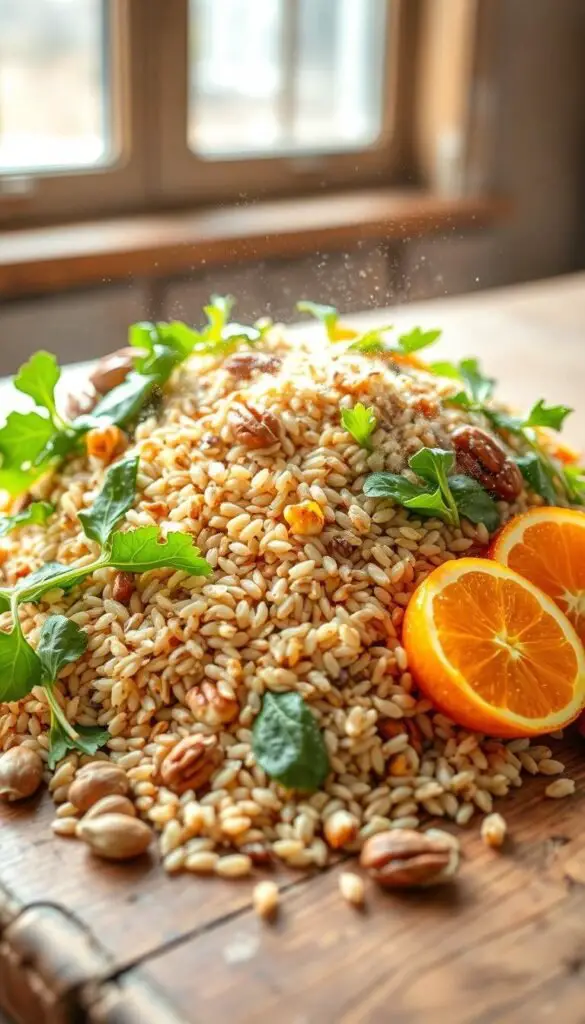
How to Prepare Grains for Salads
Cook grains right to avoid sogginess:
- Rinse grains before cooking to remove debris.
- Use the pasta method: Boil briefly then rinse under cold water.
- Let cool completely before mixing—this prevents dressing from diluting.
Prep batches weekly! Store cooked grains in airtight containers for quick assembly. Mix with greens, proteins, and your favorite dressings for fresh winter salads in minutes.
A Guide to Converting Leftovers into Salads
Don’t let leftover holiday roasts or weeknight dinners go to waste. Turn them into vibrant winter vegetable salads. These salads save time and cut down on food waste. Here’s how to make tasty cold weather salads from common leftovers easily.
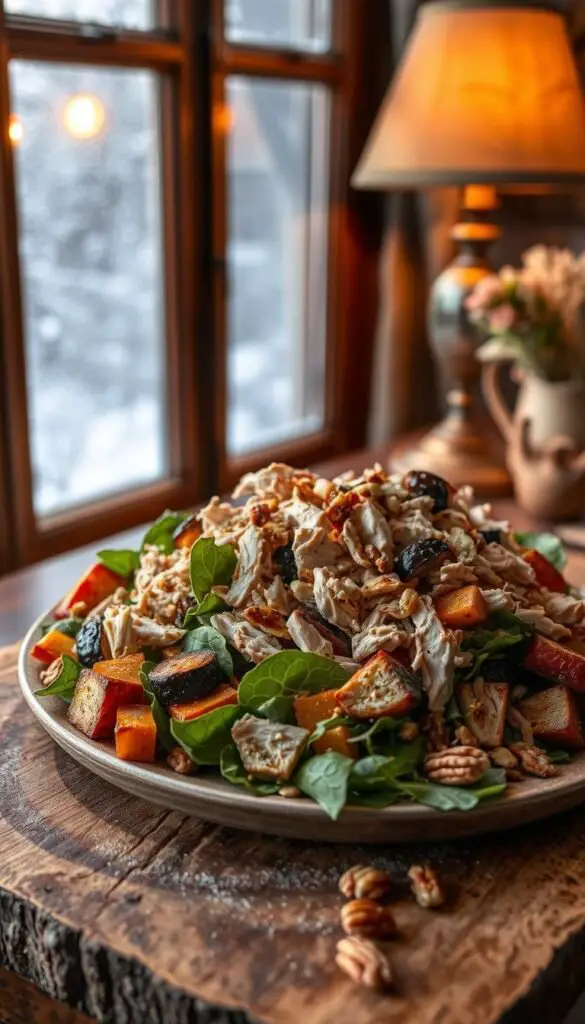
Transforming Roasted Meats into Salads
Cold cuts aren’t the only choice. Leftover roasted meats add protein to hearty winter salads:
- Thin-sliced turkey, ham, or beef paired with spinach, dried cranberries, and a honey-mustard dressing creates a satisfying cold weather salad.
- Shredded chicken mixed with kale, walnuts, and citrus segments works well with a light orange-vinaigrette.
Using Starchy Vegetables for Heartiness
Repurpose roasted potatoes or squash into substantial salads:
- Chunky roasted potatoes tossed with arugula, avocado, and a lemon-tahini dressing add creaminess and crunch.
- Sweet potato cubes combined with pomegranate seeds and feta cheese make a colorful winter vegetable salad.
Leftovers become meals that shine when paired with fresh greens and bold flavors. Every bite reduces waste and saves time.
Pairing Winter Salads with Proteins
Make your seasonal salads more filling with the right proteins. This adds a cozy touch to your meals. Choose from animal or plant-based options to keep your dishes balanced and satisfying.
Best Proteins to Complement Your Salad
Animal proteins add a rich taste to winter greens. Try these:
- Skin-on chicken thighs roasted with garlic and rosemary
- Pan-seared salt-and-pepper salmon for a fish twist
- Thinly sliced beef tenderloin for a steakhouse touch
- Crispy duck confit for bold, savory notes
Pair proteins with tangy vinaigrettes or maple-mustard glazes. This boosts the flavors.
Vegetarian Protein Sources to Consider
Plant-based options are great in seasonal salads too. Try these:
- Marinated tofu baked until crispy
- Tempeh strips stir-fried with soy-ginger sauce
- Chickpeas or cannellini beans tossed with lemon-herb seasoning
- Crispy roasted edamame or lentils for texture
Mix proteins with roasted squash, pomegranate seeds, or dried cranberries. This adds seasonal flavors. Remember, you can use what you have at home to make meals easy.
Tips for Meal Prepping Winter Salads
Meal prepping winter salads is easy. Just follow these steps to keep your salads fresh and ready fast. An organized plan keeps your healthy meals tasty all week.
How to Store Ingredients for Freshness
- Wrap leafy greens in damp paper towels before refrigerating to lock in moisture.
- Roasted veggies stay crisp in airtight containers at room temperature for 1–2 days.
- Separate acidic ingredients like citrus or vinegar until serving to prevent soggy textures.
Assembling Salads for Quick Meals
Here are some smart ways to save time:
- Layer ingredients in mason jars: Start with grains or proteins at the bottom, add veggies, and top with greens.
- Prep “salad kits” by portioning nuts, dried fruit, and dressings into small containers.
- Assemble salads only 30 minutes before eating for maximum crunch and color.
“The key to successful winter meal prep is balancing preservation with flavor retention,” says registered dietitian Emma Carter. “Prioritize texture and timing for salads that feel like fresh-made every time.”
Use stackable containers with compartments to keep ingredients separate. Cook quinoa or farro on Sunday and store it for 3–4 days. These tips make enjoying fresh winter salads on busy weekdays a breeze.
Serving Winter Salads for Gatherings
Winter salads are perfect for both festive meals and casual gatherings. They can be the highlight of your next event. Impress your guests with creative presentation and pairing ideas.
Stylish Presentation Ideas
Make your winter salads stand out with color and texture. Try stacking ingredients in glass bowls or mosaic patterns on platters. Add microgreens or edible flowers for extra flair.
Serve in hollowed-out squash or wooden boards for a rustic feel. Use metallic bowls for a modern look or woven baskets for warmth. Drizzle dressings in zigzag patterns for a fun touch.
- Use metallic bowls for a modern look or woven baskets for warmth.
- Drizzle dressings in zigzag patterns using a squeeze bottle.
- Let guests assemble their own salads at a DIY bar with toppings like crumbled cheese or candied pecans.
Pairing Winter Salads with Grilled Foods
Pair winter salads with warm dishes for a great contrast. Grilled proteins like chicken or fish complement the crispness of hearty salads. Try these pairings:
- Citrus-pomegranate salads with cedar-plank grilled salmon
- Roasted sweet potato salads alongside rosemary-marinated pork chops
- Warm farro-based salads with grilled vegetable skewers
The Role of Nuts and Seeds in Salads
Nuts and seeds take winter salads to the next level. They add crunch and depth, making meals more satisfying. Plus, they’re packed with healthy fats and protein.
Nutritional Highlights of Nuts and Seeds
Nuts and seeds are full of good fats, fiber, and vitamins. Walnuts have omega-3s for brain health. Chia seeds offer plant-based protein. Pumpkin seeds are rich in zinc, boosting immunity.
These nutrients pair well with winter veggies like sweet potatoes or Brussels sprouts.
Best Nuts and Seeds for Winter Salads
- Walnuts: Toasted walnuts add earthy flavor to salads with roasted butternut squash.
- Pumpkin seeds: Sprinkle pepitas over kale salads for a zinc-rich crunch.
- Sunflower seeds: Mix into citrus-based salads for a mild nuttiness.
- Almonds: Slice them thinly and toss with arugula and pomegranate for a festive touch.
Pro tip: Lightly toast nuts before adding to salads to enhance their natural sweetness. For warm winter salads, try stirring crushed hazelnuts into a roasted beet and goat cheese mix. Always check labels if avoiding allergens—try quinoa or crispy chickpeas as alternatives for nut-free options.
Common Mistakes to Avoid When Making Salads
Making the perfect winter salad means avoiding a few common pitfalls. Even seasoned cooks can stumble over dressing ratios or flavor imbalances. These tips help ensure every bite of your fresh winter salads hits the mark.
Over-dressing vs. Under-dressing
Too much dressing drowns out crisp greens like romaine or endive, while too little leaves ingredients dry. Start with 2 tablespoons of dressing per 4 cups of salad. Toss gently and taste before adding more. Bolder greens like kale hold up to richer vinaigrettes, while delicate spinach wilts easily. Adjust based on your seasonal salads base.
Balancing Flavors and Textures
Winter salads thrive on contrasts. Mix crunchy walnuts with creamy avocado or tangy citrus with earthy beets. Missing a flavor note? Add a drizzle of balsamic for acidity or a sprinkle of Parmesan for salt. Overpowering sweetness? A squeeze of lemon or a handful of bitter radicchio restores balance. Layer textures like chewy quinoa with crisp apple slices.
Practice these tricks to create salads that shine. With these fixes, every bowl of fresh winter salads becomes a harmonious mix of flavors and textures, perfect for cozy meals or holiday gatherings.

